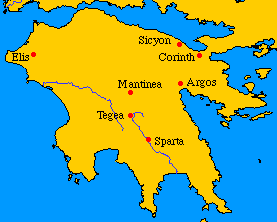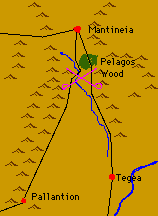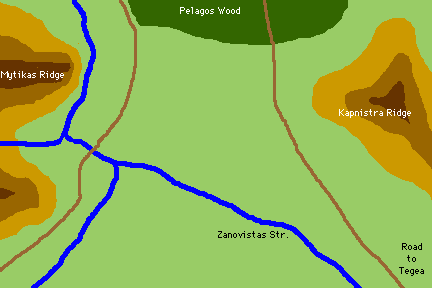Luke Ueda-Sarson's Historical Battle Scenarios for DBM:

The Second Battle of Mantinea: 362 BC

|

|



|

|

The Spartans and allies occupied the 2 kilometre-wide gap between the Mytikas and Kapnistra ridges south of the city. The Theban coalition advanced north up the road from Tegea; deployed across the plain, which is intersected by a few small paltry streams, virtually dry in the late summer season the battle was fought in, and ground arms.
Seeing this, the Spartans and their allies called a lunch-break, upon which the Thebans rapidly attacked across the plain, their deep phalanx breaking the allies. Alas, at the moment of victory, Epaminondas was mortally wounded. Deprived of their leader, the coalition forces failed to pursue the defeated allies, and the greatest Greek battle to date came to in inconclusive end.

The Thebans held the left of their line, arrayed in a 50-deep block, then came the Tegeans and then the Argives. Next were the Euboeans, Locrians, Sicyonians, Messenians, Malians and Aenianians, and then the Thessalians and remaining allies. The white-helmeted Theban cavalry was deployed on both wings, and their left wing also had Thessalian cavalry. The whereabouts of the Arcadian cavalry is unknown. The Theban cavalry was supported by hamippoi footmen which gave them the edge over their allied opposites.
During the course of the battle, the Mantinean cavalry was pushed back by the Theban and Thessalian cavalry, while on the eastern flank, the Athanian cavalry was defeated by the Theban cavalry, hamippoi and slingers deployed along the Kapnistra ridge, aided by Thessalian javelinmen.
The Theban phalanx crashed into the allied phalanx, and aided by their victorious cavaly, broke it. At this point Epaminondas was struck down, and the pursuit was not pressed. On the Eastern flank, the victorious support troops had dispersed to plunder, and were in turn defeated by the Athenian foot.
At a scale of 500/250 men per element, the forces may be conjectured thusly:
The Thebans and their allies:
1 x Epaminondas - C-in-C as Reg Sp (S)
1 x Sacred Band - Reg Sp (S)
8/18 x Theban hoplites - Reg Sp (O)
2/3 x Theban cavalry - Reg Cv (O)
2/3 x Theban hamippoi supporting cavalry - Reg Ps (S)
1/3 x Thessalian cavalry - Reg Cv (O)
1/2 x Mercenary peltasts - Reg Ps (S)
1 x Tegean ally-general as Irr Sp (O)
2 x Arcadian Eparitoi - Reg Sp (S)
15/31 x Tegean and Arcadian hoplites - Irr Sp (O)
1 x Thessalian ally-general as Irr Sp (O)
17/37 x Thessalian, Euboean and other hoplites - Irr Sp (O)
8 x Baggage - Irr Bg (I) [mobile]
1 x Argive ally-generals as Irr Sp (O)
9/21 x Argive hoplites - Irr Sp (O)
2 x Argive Epilektoi - Reg Sp (S)
1/3 x Theban cavalry - Reg Cv (O)
1/3 x Theban hamippoi supporting cavalry - Reg Ps (S)
1/2 x Thessalian cavalry - Reg Cv (O)
1 x Arcadian cavalry - Reg Cv (I)
1/2 x Thessalian slingers - Irr Ps (O)
1/2 x Thessalian javelinmen - Irr Ps (I)
1/2 x Euboean and mercenary peltasts - Reg Ps (S)
(357/655 points)
The Spartans and their allies:
1 x Mantinean ally-general as Irr Sp (O)
7/17 x Mantinean and other Arcadian hoplites as Irr Sp (O)
2/4 x Arcadian mercenaries - Reg Sp (O)
2/3 x Mantinean and Spartan cavalry - Reg Cv (I)
2/4 x Mercenary peltasts - Reg Ps (S)
1 x Spartan C-in-C as Reg Sp (S)
5/9 x Spartan hoplites - Reg Sp (S)
8/18 x Other Laconian hoplites - Reg Sp (O)
1 x Eleian ally-general as Irr Sp (O)
9/19 x Eleian, Arcadian and other states' hoplites - Irr Sp (O)
2 x Eleian picked troops - Reg Sp (O)
1/2 x Eleian cavalry - Reg Cv (I)
1 x Hegesileos - Athenian Ally-general as Irr Sp (O)
9/17 x Athenian hoplites - Irr Sp (O)
2/4 x Athenian Epilektoi - Reg Sp (O)
2/4 x Athenian cavalry - Reg Cv (O)
1/2 x Athenian akonstistai - Reg Ps (I)
8 x Baggage - Irr Bg (I) [immobile]
(284/463 points)

The Thebans and their allies face due north, the Spartans and their allies face due south. The season is (late) summer or (early) autumn: decide which randomly. The Thebans count as the invader, and so take the first move. All allies are reliable, and any PiP roll of a one in the first bound is re-rolled by the Theban side, or upgraded to a 2 for the Spartan side.
The non-hoplite troops of each side may be freely distributed before the battle; otherwise the command structures listed above should be adhered to.
Notes and special rules:
The Mytikas ridge counts as a steep hill, the Kapnistra ridge as a gentle hill with some scattered small patches of rocky ground. Two roads are present, the western one crossing the paltry stream by a ford.
In DBM v3.0, two opposing elements of Sp (S) count the (S) bonus, which is not such good thing, as it means they can't kill each other; so when Sp (S) meets Sp (S), I suggest that neither counts as (S) - they shold retan the (S) bonus against all other opponents however. I would also propose that two opposing elements of the same type that BOTH have generals don't count the generals' + 1 tactical factor. Greek generals seemed to have regularly died in the front ranks, which is very hard to do at factor 6 even if doubly overlapped.
If the Theban army is demoralized first, the Spartans and allies are the victors. If the Spartans and allies become demoralized first, keep playing the battle. A command that becomes demoralized solely due to the army becoming demoralized does not suffer the -2 combat factor penalty, and as many elements may make tactical moves as it has PiPs available for (it's elements will still flee unless moved or halted, and it may be broken subsequently in the 'normal' manner by taking losses). If they manage to destroy Epaminondas' element, before all their commands become broken (as opposed to the above special 'demoralized' catagory), then the result is a draw.


